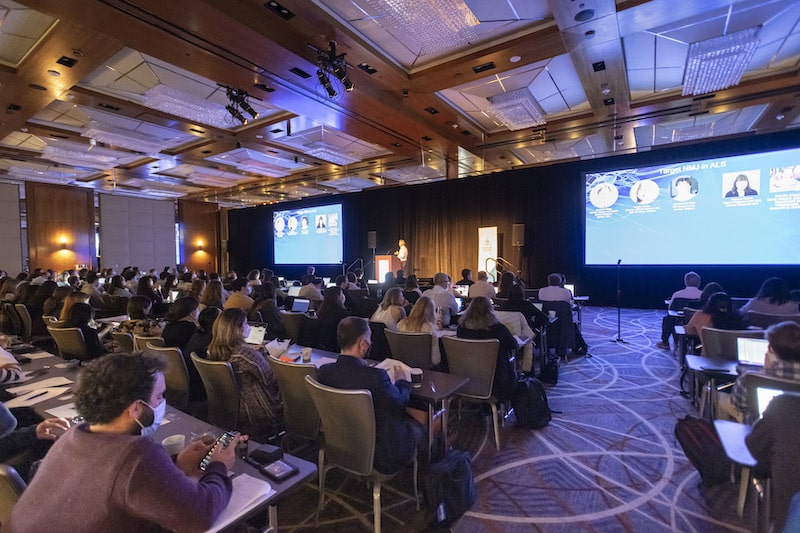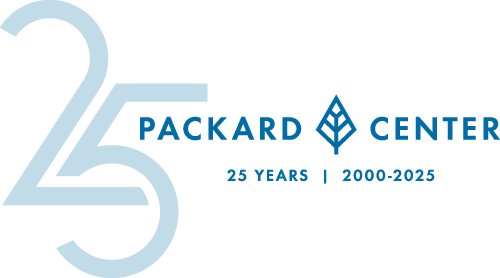


Researchers Gather Again in Baltimore for Packard Center’s Annual Research Symposium

22nd Annual Event held in person again after a two year absence
The Packard Center’s annual symposium returned to Baltimore for 2022 after going virtual last year. It was a hybrid meeting with 246 people gathering at the Four Seasons in Baltimore and an additional 175 people joining online. Regardless of how they participated, the 22nd annual symposium offered a chance for Packard scientists to come together and share their progress and challenges—the first time for any ALS science meeting in 2 years!
The meeting isn’t just a nice “extra,” but rather central to Packard’s mission and methods. These symposia offer a chance for ALS researchers to discuss the latest science, long before it is formally published. As in previous years, the presentations by scientists combined new discoveries on familiar topics—stress granules, nucleocytoplasmic transport, genetic causes such as C9orf72 and TARBDP—as well as completely novel findings, such as new disease-causing genetic variants and novel molecular pathways that may contribute to disease. Discussing failures and setbacks is also key because it allows scientists to brainstorm solutions. To facilitate this openness during the meeting, specific results cannot be shared until the findings are peer-reviewed by other researchers and published in a research journal.
The mislocalization of TDP43 is considered a hallmark of ALS as it occurs in 97% of patients, and around half of those with frontotemporal dementia (FTD). What has remained unclear is what triggers this effect, and what are the precise biophysical properties of the TDP43 aggregates that build up in the cytoplasm. Although the question is far from settled, Packard scientists have taken important steps to understand how early steps in the disease process alter the function of proteins that control the movement of molecules between the nucleus and cytoplasm (known as nucleocytoplasmic transport), and how these changes affect TDP43. Results are also emerging that suggest it might be possible to identify biomarkers of pathological mislocalization, especially through the loss of normal TDP43 function as a repressor of cryptic exons. The shift of TDP43 from the nucleus to the cytoplasm also leads to the buildup of TDP43 protein clumps in the cytoplasm. Packard scientists examined the specific physical properties of these aggregates, including their formation via a process called liquid-liquid phase separation and the accessory proteins involved in their formation and resolution.
Historically, much of the research on TDP43 has focused on toxic gain of function events, such as the protein’s mislocalization and aggregation. Emerging research first presented at the meeting, however, indicates that the loss of TDP43’s normal function as an RNA/DNA binding protein and its repression of cryptic exons plays a major role in ALS. Findings that have subsequently been published in Nature revealed that TDP43 plays a major role in suppressing cryptic exons from the UNC13A gene, and that variations in UNC13A can contribute to the speed of disease progression. Other researchers presented results about how TDP43 affects RNA turnover and other cellular functioning.
The repeat expansion in C9orf72 also remained a major focus of research. The large number of repeats in mutated copies of the gene confuse the cell’s protein-making machinery. This causes the formation of toxic dipeptide repeat proteins (DPRs) via a process called RAN translation. Further insights were gained on how DPRs drive disease and how the RAN translation process might be inhibited. As with TDP43, mutations in C9orf72 also lead to a loss of the protein’s normal function, including on the surface of lysosomes during times of nutrient stress. Researchers found that the repeat expansion could impact everything from cellular recycling to the structural proteins inside cells.
Scientists shared new discoveries related to rare genetic causes of ALS, including in young children, as well as biological processes that affect everyone with ALS. Although the new genes discovered only cause disease in a tiny subset of patients, Packard scientists are showing that these discoveries can lead to big breakthroughs in identifying biological pathways that contribute to disease. Other neuroscientists showed that these mutations can discover new drug targets and help find new drugs.
Although ALS is primarily a disease of motor neurons, the loss of these cells also leads to the degeneration of the neuromuscular junction (NMJ) and the connected muscles. Packard funded scientists shared updates on advancements in determining how to slow the loss of NMJs and molecules that can trigger repair processes. Other brain cells, such as astrocytes, also received focus at this year’s symposium.
Aside from the fantastic progress in ALS science – the opportunity to reengage with senior and junior researchers, post docs and grad students was enthralling for all. And it was clear—while as good as Zoom has been as a substitute for in-person meetings during the pandemic, the ability to interact face-to-face, during and after the meeting leads to better and more rapid progress.
The results shared at the Packard Symposium, along with those at the Answer ALS Annual meeting reveal both the progress that has been made and the amount of work that continues. Collaborations funded by the Packard Center are proving vital towards our understanding of the molecular mechanisms that drive ALS and will serve as future drug targets. The Symposium will return to Baltimore in 2023, where Packard scientists will once again come together to share their science.
~Carrie Arnold
Thank you to our Symposium sponsors:
The Berardino Family – in memory of William Gray Smith, Sr.
Amylyx
Quarlis
Sanofi
